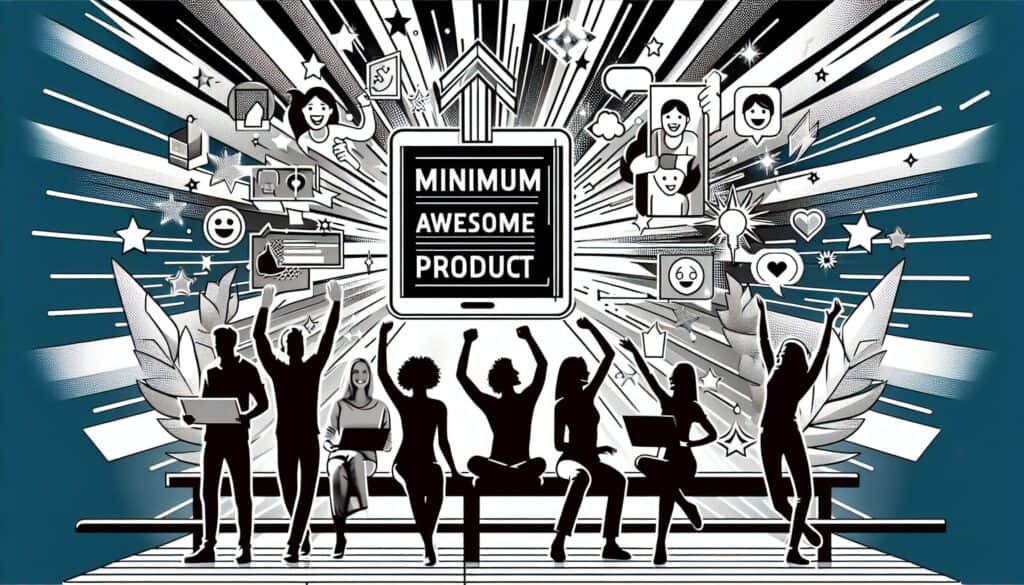To create the smallest possible product that users will find not just viable or marketable, but genuinely impressive and delightful, focusing on a high-quality expérience utilisateur for its core features.
- Méthodologies : Clients et marketing, Économie, Conception de Produits
Minimum Awesome Product (MAP)

Minimum Awesome Product (MAP)
- Méthodologie Agile, Expérience client, Innovation, Produit minimum commercialisable (PMC), Produit minimum viable (MVP), Conception de Produits, Développement de produits, Expérience utilisateur (UX), User-Centered Design
Objectif :
Comment il est utilisé :
- Teams focus on delivering a polished and highly satisfying experience for a limited set of features, aiming to generate strong positive emotional responses and early evangelists.
Avantages
- Creates strong initial user engagement and loyalty, generates positive word-of-mouth, sets a high-quality standard from the start.
Inconvénients
- Can take longer and be more expensive to develop than an MVP, 'awesome' can be subjective and hard to define, may delay market entry.
Catégories :
- Clients et marketing, Idéation, Conception de Produits
Idéal pour :
- Creating a strong positive first impression and generating early brand advocates by delivering a high-quality, delightful experience with a focused feature set.
Le Produit minimum génial (MAP) methodology finds applications in various sectors like technology start-ups, consumer electronics, and e-commerce, where rapid market entry is vital to capture user interest. Typically, it is employed during the initial phases of product development when teams prioritize a select set of features that can provide significant value and delight users. This approach often benefits from collaboration among cross-functional teams that include product managers, designers, engineers, and marketing professionals who contribute to crafting a compelling user experience. The MAP strategy can be particularly effective in industries characterized by high competition and fast-paced innovation cycles, such as mobile app development or portable technology, where first impressions significantly impact user adoption rates. Initiatives may be sparked by innovative entrepreneurs or established companies looking to launch new products, generating excitement through well-executed marketing campaigns that highlight the unique aspects of the offering. The emphasis on creating a polished experience with minimal features encourages teams to innovate within constraints, leading to the development of strong user loyalty and community support as early users share their experiences, further enhancing the product’s visibility in crowded marketplaces. This approach is increasingly recognized for its ability to set a high bar regarding quality and user engagement from the outset, establishing a foundation for scalable growth as additional features are integrated based on user feedback and evolving market demands.
Principales étapes de cette méthodologie
- Identify and define the core problem to solve.
- Select a narrow feature set that addresses the core problem.
- Develop high-fidelity prototypes that deliver exceptional user experience.
- Conduct iterative testing focused on user reactions and emotional responses.
- Refine the product through continuous feedback and improvement.
- Launch the product to a targeted audience for initial engagement.
- Create marketing strategies to enhance user delight and advocacy.
Conseils de pro
- Conduct in-depth user research to identify pain points and prioritize features that deliver significant emotional impact.
- Iterate rapidly with user feedback cycles to enhance the delight factor of the minimum feature set while maintaining quality.
- Leverage storytelling techniques in your design to create a narrative that resonates emotionally, turning users into advocates.
Lire et comparer plusieurs méthodologies, nous recommandons le
> Référentiel méthodologique étendu <
ainsi que plus de 400 autres méthodologies.
Vos commentaires sur cette méthodologie ou des informations supplémentaires sont les bienvenus sur le site web de la Commission européenne. section des commentaires ci-dessous ↓ , ainsi que toute idée ou lien en rapport avec l'ingénierie.
Contexte historique
1949
1950
1950
1960
1960
1960
1960
1940
1950
1950
1958
1960
1960
1960
1960
(si la date est inconnue ou n'est pas pertinente, par exemple "mécanique des fluides", une estimation arrondie de son émergence notable est fournie)















Articles Similaires
Gestion des opérations de fabrication (MOM)
Système d'exécution de la fabrication (MES)
Plan de contrôle de la fabrication
Tests manuels
Tableaux d'évaluation des manutentions manuelles (MAC)
ManTRA (outil d'évaluation des risques liés aux tâches manuelles)